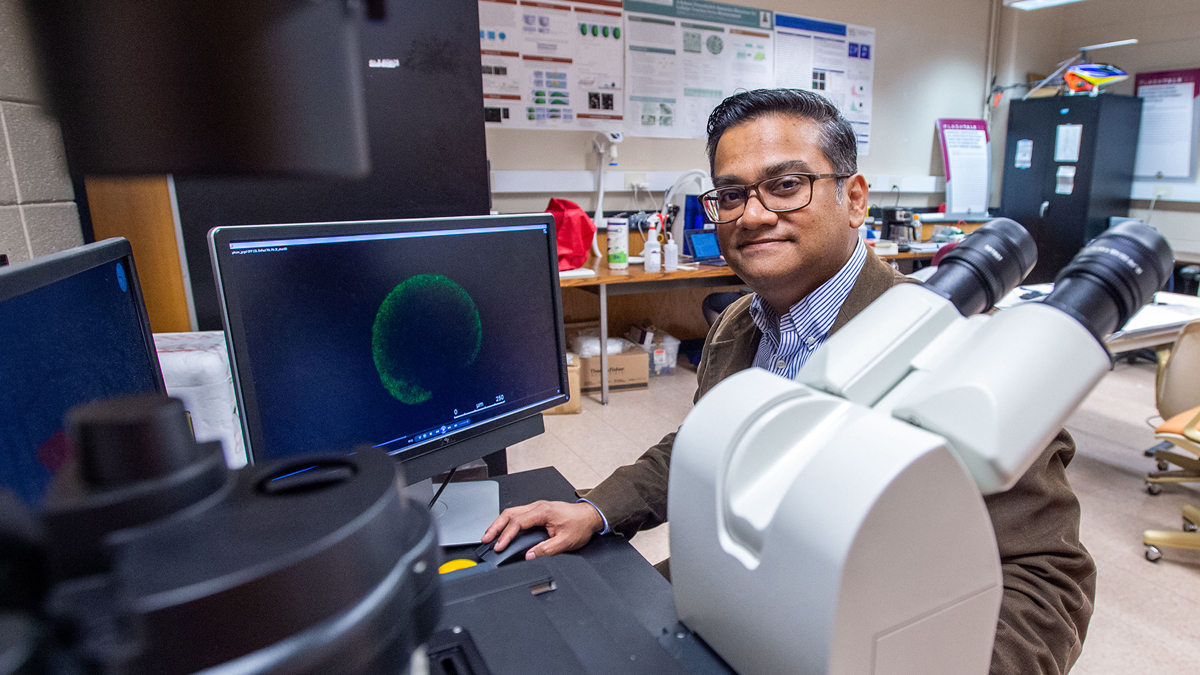
Farhan Chowdhury, associate professor of mechanical engineering at Southern Illinois University Carbondale, recently received a $442,500 grant from the National Institutes of Health. He will use it to study ways to meet an engineering challenge: creating lab-grown stem cells for specific types of body cells, such as heart, skin, or other organ tissue. (Photo by Russell Bailey)
August 25, 2021
SIU engineering professor uses NIH grant to probe how stem cells become specific tissue
CARBONDALE, Ill. — When you receive an injury to your body, stem cells come to the rescue. Now, a Southern Illinois University Carbondale researcher will use a grant to study ways to create and direct massive numbers of stem cells to speed healing, even when the injury is beyond the body’s typical ability to heal itself naturally.
Farhan Chowdhury, associate professor of mechanical engineering and energy processes, recently received a $442,500 grant from the National Institutes of Health. He will use it to study ways to meet an engineering challenge: creating lab-grown stem cells for specific types of body cells, such as heart, skin, or other organ tissue.
Work began July 1 and will continue through July 2024 during this first phase.
Much of the work will center on better understanding the ways in which stem cells are signaled to develop into the types of cells the body needs. Scientists have believed that stem cells receive chemical signals for this purpose. They now believe physical signals from the extracellular matrix – the tissues around the cells – might also play a crucial role in determining the type of cell the given stem cells ultimately play.
In addition to investigating chemical signaling of stem cells, Chowdhury’s grant will allow his team to investigate the effects of these tiny physical signals, which involve mechanical, microenvironment, and single molecular forces.
The research has the potential to revolutionize critical care for people badly injured in accidents, warfare or other incidents.
“That is when the creation and unlimited supply of functional body cells in a laboratory setting becomes critical,” Chowdhury said. “Overall, the proposed work will shed light on the detailed molecular and mechanical pathways of stem cell lineage, and what makes those cells commit to a certain cell type.”
The grant will fund the research for three years and can be renewed through a competitive process. In keeping with SIU’s focus on involving undergraduate students in cutting-edge research, up to three undergraduate students will be involved in the work, as well as two graduate students.
“The students will gain research experience in rigorous and intensive research in the areas of stem cells, cell mechanics, and biophysics,” Chowdhury said. “Students will conduct experiments, analyze and summarize data and prepare manuscripts advancing the proposed scientific agenda.”
Stem cells to the rescue…
Stem cells have the ability to grow into many things the body needs, such as new skin, bone, or other tissues. But science has yet to determine just how a stem cell knows what to become – its “fate” in a sense – let alone how to control it.
Almost all tissues in the human body include stem cells, which are on call to provide regeneration and injury repair. The human body constantly requires such upkeep, either due to natural aging or traumatic injury. Such issues account for up to one half of the amount spent on health care worldwide.
Unlocking secret forces
So why is a mechanical engineer is involved in understanding this critical biological process? Because some such processes involve tiny machine-like functions.
Lack of precise, laboratory control of so-called single-molecule level forces – possibly coupled with the interplay of chemical signals – has prevented medical researchers from controlling stem cell fate in the lab. Chowdhury wants to investigate mechanical frameworks for controlling the fate of pluripotent epiblast stem cells created in the lab using both chemical and single-molecule force approaches.
He hopes using the two approaches together might unlock secrets in their synergy, which in turn might reveal how scientists might determine stem cell fate in the lab, thus opening the door to the therapeutic treatments in the future.
“The central hypothesis is that the synergistic effect of chemical and single-molecule force cues, sent through the extracellular matrix and cell-to-cell interaction, can control fate decisions far more effectively than previously possible,” Chowdhury said. “The long-term goal is to develop novel approaches to control the directed differentiation of pluripotent cells.”
Engineering on the tiniest level
Chowdhury will be working with pluripotent epiblast stem cells, which have the ability to indefinitely divide and produce exact copies of themselves. During the first part of the work, the team will focus on understanding the physical mechanisms in the single-molecule forces involved with differentiating pluripotent epiblast stem cells into mesodermal cells, a type of cell present in the early developing stages of embryos. In the later stages of development, these mesodermal cells give rise to tissues such as cardiac muscles, skeletal muscles, smooth muscles, red blood cells.
To do this, Chowdhury will use tiny tension gauge tethers that are built from DNA designed to rupture at a defined force level. This precise control of forces at the single molecule level will allow to engineer cell fate than previously possible.
“Together with chemical signaling, such precise control and specific targeting of mechanical pathways may lead to superior control of cell differentiation into the mesoderm,” he said.
Additional study will involve studying how these cells renew themselves, as well as using something called a “nano-yoyo” to further define the mechanical forces responsible for controlling the cells’ fates.
“The proposed work will elucidate detailed molecular, chemical and mechanical pathways that contribute to specific lineage commitments,” Chowdhury said.
